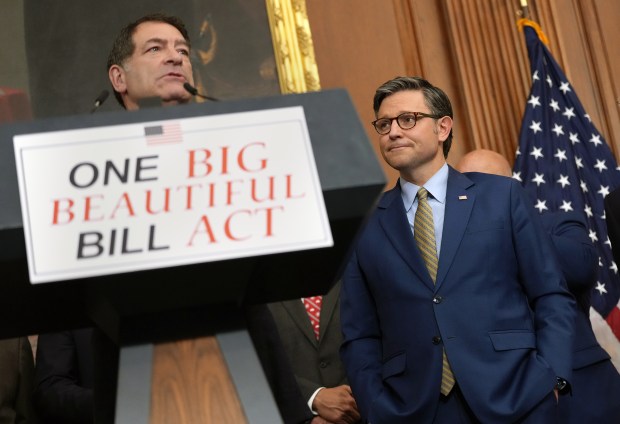CTA leadership keeps telling us our public transit system is getting safer.
A scan of CTA news releases on crime statistics over the past few years shows that the agency reports to the public only when reported crimes on the system fall in a given month. The timing of the releases seemingly is random; there’s no discernible schedule. That suggests we hear the “good” news only when there is any and never the bad from the agency charged with getting Chicagoans where they want to go efficiently, and doing it safely.
Ask any random Chicagoan whether they think the “L” and buses are “safe,” and you’re likely to hear a different story. But public sentiment doesn’t always correspond to statistical trends, as politicians frequently like to remind us when confronted with concerns about crime. So we checked the statistics — the ones compiled by the Chicago Police Department, not those laid out strictly in percentage terms in CTA news releases — and the worries are not all in people’s heads. Crime remains a problem on the CTA.
Here’s what the CPD data show: Reported serious crimes — we chose battery, robbery, assault, homicide, sex offenses and weapons violations — at CTA stations and on CTA trains and buses numbered 1,667 last year, the highest level since 2000 other than in 2019, which was slightly worse. Through August of this year, those reported crimes numbered 1,260 — on track at the very least to replicate last year’s figures. Battery, robbery and assault made up the vast majority.
These, of course, are only reported crimes. The actual number is understated due to victims who choose not to file police reports.
The issue of safe public transit jarringly is back near the top of the long list of concerns about life in Chicago because of the shocking shooting deaths early Labor Day morning of four people sleeping on a CTA train. Discovery of the gruesome scene was made at the Forest Park station at one end of the Blue Line; at the other end of the line, of course, is O’Hare International Airport, the main gateway to Chicago for out-of-towners. Charged with the slayings is 30-year-old Rhanni Davis of Chicago.
At a news conference Tuesday, Cook County State’s Attorney Kim Foxx referred to the crime more than once as “heinous” and said officials still don’t understand what allegedly motivated Davis, who has a lengthy criminal history, albeit made up of misdemeanor charges, particularly gun offenses. “I fear,” Foxx said, “the question of why may never be answered because sometimes truly horrific, heinous acts have no answer.”
CTA President Dorval Carter Jr. said he couldn’t remember such a mass killing occurring before on the CTA and said he didn’t think homeless people on the trains, as at least some of the four victims were, are unsafe because of this awful event.
It’s fair, we think, to regard these killings with no obvious motive as anomalous. And the CTA’s sprawling network of cameras — one of the most expansive of any U.S. transit system, the agency says — helped immeasurably in identifying Davis as a suspect and has been useful in apprehending other offenders.
But this appalling crime, reported across the country and indeed even internationally, serves yet again to underscore the perception of Chicago as unsafe and awash in guns. That it took place only a few weeks after the Democratic National Convention served as a grisly reminder of how the surprisingly smooth convention week belied the city’s persistent difficulties.
The news of the Blue Line homicides coincided with a federal judge’s ruling that Illinois couldn’t forbid licensed concealed carry permit holders from riding the rails and buses while armed. The applicability of the ruling still is to be determined. But one attorney for the plaintiffs tapped straight into public skittishness over whether it’s safe to use public transit in Chicago. “This is an important ruling regarding locations where law-abiding persons have too often been vulnerable,” the attorney told the Tribune.
Even if the Forest Park homicides don’t by themselves call into question the CTA’s safety record, it’s fair to say the CTA has struggled to return the system to a status approaching normal notwithstanding Carter’s assertions that things are improving. The CTA isn’t yet close to fully recovering from the shock of the pandemic, when ridership plummeted and trains in particular noticeably descended into much more visible lawlessness.
Much of that lawlessness took the form of nuisance offenses such as smoking and littering, which made riding the “L” unpleasant, if not dangerous. In addition, with the proliferation of empty or near-empty trains, homeless Chicagoans took in far greater numbers to sleeping in trains and piling up their belongings in the railcars.
Unenforced and obnoxious offenses such as smoking on the train give the impression of a system in which the rules — written and unwritten — don’t apply. It’s not hard to see how criminals can be emboldened in such an environment.
In one respect, the proliferation of crime on the CTA is a manifestation of the public safety crisis confronting Chicago as a whole. But special attention must be paid to keeping trains and buses safe if Chicago is to get its post-pandemic footing back.
There’s little doubt that fear of public transit, whether or not it’s fully justified, is holding back ridership and leading to ills such as yawning budget deficits for the transit system, traffic-choked highways, pollution and economic malaise. Chicago is blessed with a public transportation system that can get you almost anywhere, certainly within the city and out to most suburbs as well. The more usage the system gets, the better for all of us.
So we hope that the Blue Line killings, tragic and awful as they are, spur Chicago Mayor Brandon Johnson, police Superintendent Larry Snelling, Carter and others to focus more intently and creatively on getting things under control and improving the environment and experience on the trains and buses that are as vital to the city’s health as blood vessels are to a human body.
Submit a letter, of no more than 400 words, to the editor here or email letters@chicagotribune.com.




